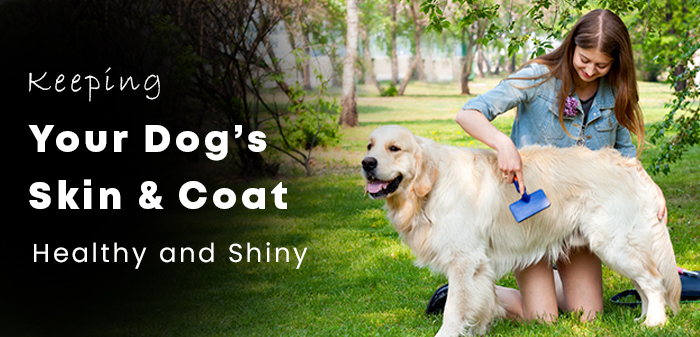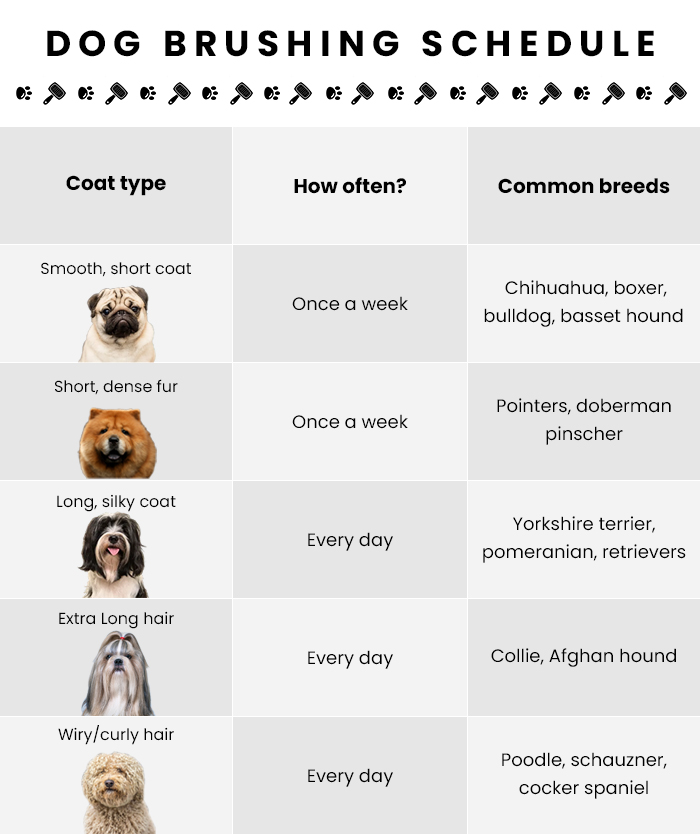Keeping Your Dog’s Skin & Coat Healthy and Shiny

A healthy skin and lustrous coat are key indicators of a dog’s health. It also makes the dog look and feel good without paying an expensive visit to the groomer. If your dog’s coat has been lacking that luster lately or if you are looking for ways to improve your dog’s skin and fur health, read on to know what you should consider.
The Science Behind a Healthy Dog Skin & Coat
First, it is important to understand that healthy skin and coat start from within. If your canine companion is healthy on the inside, its skin and coat will remain great on the outside. But what does it mean to remain healthy on the inside?
Just like us humans, nutrition is the secret to a healthy skin and coat. A diet packed with essential fatty acids, proteins, and vitamins makes the skin healthier by boosting collagen and the coat shinier by retaining moisture.
Essential fatty acids, including omega-3 (DHA, EPA, and ALA), omega-6 (linoleic acid), and omega-9 (oleic acid), support quick cell regeneration, reduce inflammation, and help with the growth of healthy skin cells and hair follicles.
B vitamins, including biotin, also play an important role in maintaining your pet’s skin condition as they aid the functioning of linoleic acid in the dermis and epidermis. On the other hand, minerals like zinc promote water retention in the skin and assist in DNA replication for quick cellular turnover caused by constant shedding in dogs.
Feeding your dog a well-balanced diet comprised of omega fatty acids, vitamins, and minerals can thus promote vitality, boost coat gloss, and reduce the dryness and flakiness of the skin.
Unhealthy vs. Healthy Dog Skin & Coat
So, how to tell if your dog’s skin is healthy or if it needs a little extra care? Here are a few signs that provide a window into your dog’s coat and skin health.
#Signs of Unhealthy Dog Skin and Coat
- Dull coat
- Matted fur
- Excessive shedding
- Bald patches
- Brittle coat
- Greasy or dry skin
- Flaky skin
- Skin allergies
- Excessive licking
- Excessive scratching
#Signs of Healthy Dog Skin and Coat
- Soft skin
- Clear and supple skin
- Shiny coat
- Vibrant color
- No flakes and dandruff
- No bumps
- Even skin tone
- Full and even coat
An unhealthy coat may indicate the presence of parasites, a lack of nutrition, or a poor grooming regime. If you spot any signs of unhealthy skin or coat, consult your vet to determine the underlying condition to blame.
If your dog’s coat is healthy and shiny and you are looking for ways to care for it, some of the tips and tricks mentioned below will help.
10 Ways to Improve Your Dog’s Skin & Coat Health
1. Bathe Your Dog Regularly
Bathing your dog regularly is the most crucial step to keeping the fur clean and healthy. It effectively removes dirt, product buildup, and excess oils from the skin, leaving the skin clean and refreshed. Bathe your dog with lukewarm water and massage the dog shampoo on their coat for a few minutes for maximum effectiveness. Don’t forget to towel dry them after rinsing to avoid water splashes all around your house.
2. Feed a High-Quality, Balanced Diet
Now that you know the science behind a good coat and skin, you know how important it is to feed a well-balanced diet. Ensure your dog’s meals consist of foods that improve dog skin health, like fish or fish oil, chicken, lamb, eggs, pumpkin, flax seeds, coconut, peanut butter, yogurt, oatmeal, carrots, sweet potatoes, cranberries, carob, etc. If your dog is prone to skin allergies, you can ask your vet to suggest a skin and coat diet that is suitable for your dog.
3. Provide Skin and Coat Supplements
In addition to a diet full of vegetables, fruits, and lean proteins, giving skin and coat supplements to your dog is a great way to boost your dog’s nutrition. You can use skin and coat supplements for dogs like Essential 6 which mainly includes omega fatty acids (3, 6, and 9) and vitamins and minerals to improve coat health, and Dorwest Wheatgerm capsule or oil that contains vitamin E to promote healthy skin and coat.
4. Make Time for Grooming Your Dog
Most veterinarians recommend daily or weekly grooming for dogs. Regularly brushing your dog’s coat with a suitable coat brush helps spread natural oil from follicle to tip and hence keeps the coat soft and lustrous. It also helps remove knots or tangles in long-haired breeds. Moreover, you will also get to check your dog’s coat for any bacterial or parasitic infections while grooming them.
Dog Brushing Schedule:

5. Try DIY Dog Skin and Coat Care
Bathing and grooming your dog doesn’t have to be boring or expensive. You can whip up natural DIY skin and coat care like a coconut oil massage that improves skin moisture and reduces itchiness or an oatmeal bath that adds sheen to your dog’s coat while relaxing him. Olive oil, fish oil, or chamomile also work as natural remedies for dry, itchy, or undernourished skin.
6. Exercise Your Dog Regularly
Exercise can help improve your dog’s skin and coat in several ways. It improves blood circulation throughout the animal body, which promotes the delivery of oxygen and nutrients throughout the skin. Improved blood flow helps improve the softness and elasticity of the skin.
7. Keep Your Dog Hydrated
Hydration is necessary for a gleaming dog coat. Inadequate hydration may lead to dryness and flakiness of the skin. Generally, dogs need one ounce of water per pound of body weight. However, it may differ according to the breed and size of your dog as well as the climate of your area.
8. Protect Your Dog’s Skin Against the Sun
Harmful UVA and UVB rays of the sun can damage your dog’s skin. Excess sun exposure may lead to dryness, sunburn, and even cancer in dogs. Therefore, consider using pet sunscreens like Petscreen SPF23 Sunscreen and SunFREE Pet Sunscreen which offers reinforced hydration and long-term protection against the sun. If your dog has sensitive skin, avoid letting them out in the sun.
9. Prevent Fleas and Ticks on Your Dog
Pesky parasites like fleas, ticks, and mites cause irritation and itching. These pests may also cause fur loss or bald patches due to excessive licking and scratching. If not treated on time, flea and tick infestations may cause several other health problems in dogs. Keeping your active dog on regular monthly flea and tick treatments helps prevent such issues and supports skin and coat health.
10. Choose the Right Skin and Coat Care Products
The skin and coat care essentials that are specifically formulated for dogs ideally work well for them. However, it is necessary to choose the shampoos, conditioners, sunscreens, lotions, moisturizers, and skin balms that suit your dog’s skin and coat and are free from chemicals, fillers, and junk. You can also select from the dog shampoos that are specifically formulated for specific breeds or coat colors.

